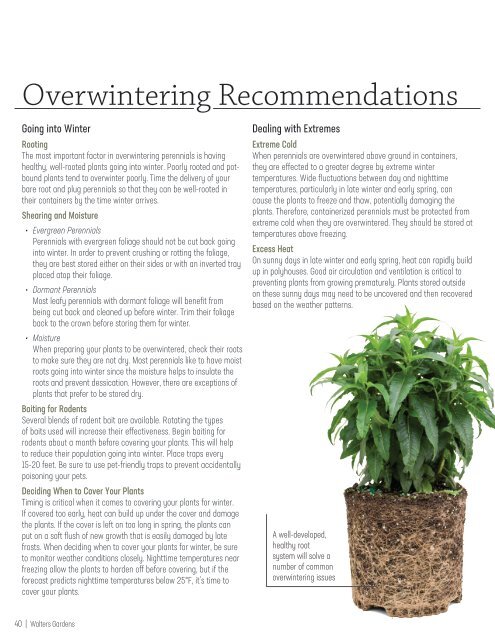Simple Sensible Solutions
The 7th edition of our Simple, Sensible, Solutions® guide. This color guide is packed with helpful information for green industry businesses who are growing and merchandising perennials.
The 7th edition of our Simple, Sensible, Solutions® guide. This color guide is packed with helpful information for green industry businesses who are growing and merchandising perennials.
Create successful ePaper yourself
Turn your PDF publications into a flip-book with our unique Google optimized e-Paper software.
Overwintering Recommendations<br />
Going into Winter<br />
Rooting<br />
The most important factor in overwintering perennials is having<br />
healthy, well-rooted plants going into winter. Poorly rooted and potbound<br />
plants tend to overwinter poorly. Time the delivery of your<br />
bare root and plug perennials so that they can be well-rooted in<br />
their containers by the time winter arrives.<br />
Shearing and Moisture<br />
• Evergreen Perennials<br />
Perennials with evergreen foliage should not be cut back going<br />
into winter. In order to prevent crushing or rotting the foliage,<br />
they are best stored either on their sides or with an inverted tray<br />
placed atop their foliage.<br />
• Dormant Perennials<br />
Most leafy perennials with dormant foliage will benefit from<br />
being cut back and cleaned up before winter. Trim their foliage<br />
back to the crown before storing them for winter.<br />
• Moisture<br />
When preparing your plants to be overwintered, check their roots<br />
to make sure they are not dry. Most perennials like to have moist<br />
roots going into winter since the moisture helps to insulate the<br />
roots and prevent dessication. However, there are exceptions of<br />
plants that prefer to be stored dry.<br />
Baiting for Rodents<br />
Several blends of rodent bait are available. Rotating the types<br />
of baits used will increase their effectiveness. Begin baiting for<br />
rodents about a month before covering your plants. This will help<br />
to reduce their population going into winter. Place traps every<br />
15-20 feet. Be sure to use pet-friendly traps to prevent accidentally<br />
poisoning your pets.<br />
Deciding When to Cover Your Plants<br />
Timing is critical when it comes to covering your plants for winter.<br />
If covered too early, heat can build up under the cover and damage<br />
the plants. If the cover is left on too long in spring, the plants can<br />
put on a soft flush of new growth that is easily damaged by late<br />
frosts. When deciding when to cover your plants for winter, be sure<br />
to monitor weather conditions closely. Nighttime temperatures near<br />
freezing allow the plants to harden off before covering, but if the<br />
forecast predicts nighttime temperatures below 25°F, it’s time to<br />
cover your plants.<br />
Dealing with Extremes<br />
Extreme Cold<br />
When perennials are overwintered above ground in containers,<br />
they are effected to a greater degree by extreme winter<br />
temperatures. Wide fluctuations between day and nighttime<br />
temperatures, particularly in late winter and early spring, can<br />
cause the plants to freeze and thaw, potentially damaging the<br />
plants. Therefore, containerized perennials must be protected from<br />
extreme cold when they are overwintered. They should be stored at<br />
temperatures above freezing.<br />
Excess Heat<br />
On sunny days in late winter and early spring, heat can rapidly build<br />
up in polyhouses. Good air circulation and ventilation is critical to<br />
preventing plants from growing prematurely. Plants stored outside<br />
on these sunny days may need to be uncovered and then recovered<br />
based on the weather patterns.<br />
A well-developed,<br />
healthy root<br />
system will solve a<br />
number of common<br />
overwintering issues<br />
40 | Walters Gardens















